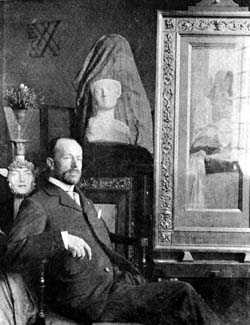Fernand Khnopff: Inner Visions and Landscapes
exhibition
home | Khnopff's biography | selected
works | press release | public
events

Fernand Khnopff (1858-1921)
The works of Fernand Khnopff (b. Grembergen 1858 - d. Brussels 1921) reflect a distinctive and intriguing artistic personality and provide an illuminating window on the complexities of the early modern age. Born into an old cosmopolitan family, Khnopff spent the greater part of his childhood in Bruges, Belgium. This somewhat moribund and decadent city left an indelible impression on the young artist-to-be, though he was not quite eight years old when the family moved to Brussels. To please his parents, Fernand Khnopff started studying law at the Université libre in Brussels. However, he was drawn to emerging innovations in literature and painting and left the university to study with Xavier Mellery, an artist of dreamlike imagery. At the Brussels Academy of Fine Arts, he took drawing lessons alongside James Ensor, who would become a leader of the Expressionist movement and Khnopff”s bitter rival. Khnopff also spent extended periods in Paris, where he studied the work of J.A.D. Ingres (1780-1867) and Eugène Delacroix (1798-1863), and was impressed by contemporary artists Gustave Moreau and Alfred Stevens, as well as the English Pre-Raphaelites.
Fernand Khnopff has been described as the “perfect Symbolist.” Khnopff developed his art in a highly intellectual milieu, which had an ancient heritage, but was on the vanguard of modernism. Belgium, in the late nineteenth century, was at the forefront of industrialization and European economic development, and Brussels became a leading international center for art through the groundbreaking exhibitions of Les Vingt (1883-1893) and La Libre Esthétique (1893-1914). Even when exhibited amid the bold experiments of artists like Georges Seurat, Paul Gauguin and Auguste Rodin, Khnopff’s striking compositions, perfect technique, and enigmatic imagery received high acclaim. They disturbed the assumptions of the viewer with subtle, but challenging, pictorial constructions. Stylistically, Khnopff combines the visual precision of earlier Flemish artists of the €fteenth century, the modern realism of the Pre-Raphaelites and, even, photography. Khnopff produced evocative landscapes and sensitive portraits, as well as mysterious allegories. His works include paintings, drawings, prints, photographs, and sculptures. He also contributed to the development of modern architecture, designing his own unique house, which anticipated the designs of architects of the Vienna Secession.

